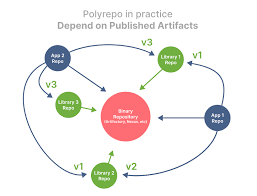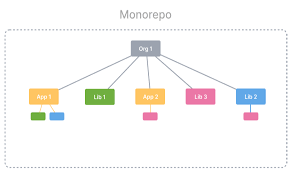Polyrepo or Monorepo? Both approaches have their advocates, each claiming unparalleled benefits for different scenarios. Polyrepo advocates cherish the freedom and autonomy it offers, while Monorepo proponents celebrate the cohesion and streamlined collaboration it brings. It’s a decision that can significantly impact your team’s productivity, codebase maintainability, and overall development velocity. So, in this article, we will discuss what is Polyrepo and Monorepo, see their pros and cons and which one be most suitable for your project.

What is Polyrepo?
Polyrepo, short for “multiple repositories,” is an approach where each project or component has its own separate repository. This means that the code for different parts of your application is stored in different repositories, allowing for more autonomy and independence between projects. Polyrepo architecture is often favoured by teams that value flexibility and isolation between different components.

Pros of Polyrepo
1. Modularity and Isolation
One of the main advantages of Polyrepo architecture is the ability to have clear boundaries and separation between different projects or components. Each repository can have its own development workflow, dependencies, and release cycle, allowing teams to work independently. This modularity can make it easier to manage and scale projects, as changes in one component, do not necessarily affect others.
2. Code Management and Collaboration
Polyrepo architecture can simplify code management and collaboration, especially for larger teams or distributed development environments. Each team or developer can focus on their specific project or component, without the need to navigate a large, centralized codebase. This can improve productivity and reduce the risk of conflicts or merge issues.
3. Scalability and Flexibility
Polyrepo architecture provides more flexibility when it comes to choosing different technologies, frameworks, or programming languages for different projects or components. This can be particularly beneficial for larger organizations that have diverse tech stacks or teams working on different parts of the application. Each team can choose the tools that best suit their specific needs, without being limited by the constraints of a single codebase.
Cons of Polyrepo
1. Code Sharing and Reusability
One of the challenges with Polyrepo architecture is code sharing and reusability. Since each project has its own repository, it can be more difficult to share code between different projects or components. This can lead to code duplication, inconsistencies, and increased maintenance efforts. Proper governance and guidelines are required to ensure that code is effectively shared and reused across repositories.
2. Cross-Project Changes
Managing changes that span multiple projects or repositories can be more complex in a Polyrepo architecture. Coordinating changes and ensuring compatibility between different components may require additional effort and coordination. This can slow down development cycles and increase the risk of errors or conflicts.
3. Dependency Management and Version Control
Polyrepo architecture introduces challenges when it comes to managing dependencies and version control. Each project or component may have its own set of dependencies, which can lead to version conflicts and compatibility issues. Proper dependency management strategies and tools need to be in place to ensure smooth integration and deployment.
What is Monorepo?
Monorepo, short for “single repository,” is an approach where all the code for a project or organization is stored in a single repository. This means that all the projects, components, and shared code are housed in a centralized location. Monorepo architecture is often favoured by teams that value code consistency, collaboration, and streamlined development workflows.

Pros of Monorepo
1. Code Management and Collaboration
One of the main advantages of Monorepo architecture is the ability to have a centralized codebase, making code management and collaboration more streamlined. All the code for different projects or components is easily accessible in one place, reducing the need for complex branching and merging strategies. This can save time and reduce the risk of errors.
2. Code Sharing and Reusability
Monorepo architecture encourages code sharing and reusability. Since all the code is stored in one repository, it is easier to share components, libraries, and dependencies between different projects or components. This can lead to faster development cycles, better collaboration, and improved code quality.
3. Version Control and Release Management
With Monorepo architecture, version control and release management become more straightforward. Changes and releases can be tracked and managed more effectively, as all the code is in one place. This can simplify the continuous integration and continuous deployment (CI/CD) pipeline, making it easier to test and deploy changes.
Cons of Monorepo
1. Size and Scalability
As the codebase grows, managing a large Monorepo can become more challenging. The larger the codebase, the longer the build times, which can slow down development cycles. It is important to establish clear guidelines and best practices for managing large codebases, such as modularization and efficient testing strategies, to mitigate these challenges.
2. Dependency Management and Version Control
With all the code in one repository, managing dependencies and version control can become more complex. Changes to one component may impact others, requiring careful coordination and testing. It is important to establish proper dependency management and version control strategies to avoid conflicts and maintain code stability.
3. Limited Flexibility
Monorepo architecture may not be suitable for projects that require the use of multiple languages or frameworks. While it is possible to work with multiple languages or frameworks in a Monorepo, it can increase the complexity of the codebase and make it harder to maintain over time. Polyrepo architecture may offer more flexibility in such scenarios.
Making the Decision

Choosing between Polyrepo and Monorepo architecture depends on various factors such as team size, project complexity, collaboration requirements, and development goals. It is crucial to consider these factors and evaluate the pros and cons of each approach before making a decision.
For smaller teams or projects with simpler requirements, Polyrepo architecture can provide more flexibility and autonomy. It allows for easier management of individual components, reduces conflicts, and enables teams to work independently.
On the other hand, Monorepo architecture can be beneficial for larger teams or projects that require code consistency, collaboration, and streamlined workflows. It simplifies code management, encourages code sharing and reusability, and provides better visibility into the entire codebase.
Ultimately, the choice between Polyrepo and Monorepo depends on your specific project needs and team dynamics. It is important to carefully evaluate the trade-offs and choose an architecture that best aligns with your development goals and organizational requirements.
Conclusion
Polyrepo and Monorepo are two different architectures with their own set of advantages and challenges. Choosing the right approach depends on factors such as team size, project complexity, collaboration requirements, and development goals. Polyrepo provides flexibility and autonomy, while Monorepo offers code consistency and streamlined collaboration. It is crucial to consider these factors and evaluate the pros and cons of each approach before making a decision. With careful consideration and proper implementation, both Polyrepo and Monorepo can be effective solutions for managing and scaling your software projects.
Thank you for reading! If you have any feedback or notice any mistakes, please feel free to leave a comment below. I’m always looking to improve my writing and value any suggestions you may have. If you’re interested in working together or have any further questions, please don’t hesitate to reach out to me at fa1319673@gmail.com.